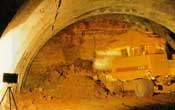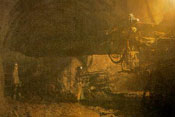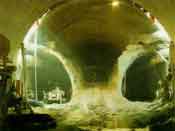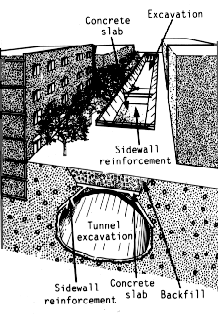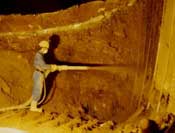You are here
Light at the End of the Tunnel
Light at the End of the Tunnel
The New Austrian Tunnelling Method is beginning to carve out an excellent world-wide reputation.
Construction Technology International 1990
Construction Technology International
Cornhill Publications Limited - London, UK
1990
Although the rock qualities upon which the New Austrian Tunnelling Method (NATM) depends for its success are not new, the degree to which they are called upon to work for themselves during tunnel excavation, according to this concept, are. So too are the developments in the field of rock mechanics revealed by the increased application of the method in various rock and ground types.
"Rock quality and its behaviour when excavated depends on when and how the rock was formed and how it has weathered over the ensuing millennia. Few rock types have the same characteristics and even less behave in the same way when excavated or tunnelled through. All rock and soil has, to a greater or lesser degree, the inherent ability to support itself or stand freely for a certain amount of time. Strong rock can remain free standing for hundreds of years while the self-supporting ability of rocks and soils of the weaker types is relatively short-lived and measured in minutes rather than hours, days or years.
This self-supporting strength of rock was the only means by which early man was successfully able to excavate underground space. In more recent times, however, various methods have been developed whereby the quality of the around through which the tunnel passes is used to minimise the cost of tunnelling. This is achieved by increasing the rate of production and minimising the amount of extra support applied.
In 1848, the mines head office of Prib am, Czechoslovakia, attempted to use fast-setting mortar to avoid heavy timber support in a coal-mine at Wejwanow. At the same time, Karl Ritter, a Swiss engineer, proposed curved tunnel sections with immediate closure of the invert to provide a closed ring in any squeezing ground. This was probably a result of the 1818 patent of Brunel's circular soft ground tunnelling shield in Britain.
Indeed the concrete segmental wedgeblock tunnel-lining system pioneered in Britain in the 1960s, particularly in London clay, relies on the quality of the clay to maintain the integrity of the non-bolted expanded ring of segments.
|
|
Arriving at the most cost effective method of tunnelling depends largely on the ability of the designer to assess the rock's own self supporting ability. Until very recently, this has been mainly a matter of the skill of the engineer and of learning from past experience. It has been the advent of sophisticated instrumentation and its knowledgeable application to the measurement of rock and ground strength that has allowed engineers to maximise the self-supporting qualities. Equally important is the belief that the surrounding ground should be allowed to deform slightly before the final support is applied in order to minimise the development of loads on the final lining. This concept is based on a theoretical investigation by Engesser in 1881 and was applied by Schmid in 1926. |
This philosophy was also expounded by the eminent Austrian engineer. Professor Ladislaus von Rabcewicz, who invented the dual-lining support system of initial support followed by a final lining. Together with his colleague, Professor Leopold Müller, and others, the introduction of systematic anchoring and in situ measurements, based on the rock mechanics theory of the 'Salzburg Kreis', is the main achievement of the Austrians. These principles have developed into what is now known as the NATM or the New Austrian Tunnelling Method.
Although the NATM is the title given to the first attempts to apply the new measuring techniques to the field of tunnel design and excavation, much of the technology necessary to implement the technique today was invented by people in totally different fields. For example, the idea of spraying concrete, or shotcrete as it is called, against the tunnel wall, is attributed to Carl E Akeley, a taxidermist who in Chicago in 1907, built a machine to spray mortar on the skeletons of dinosaurs to protect them from pollution.
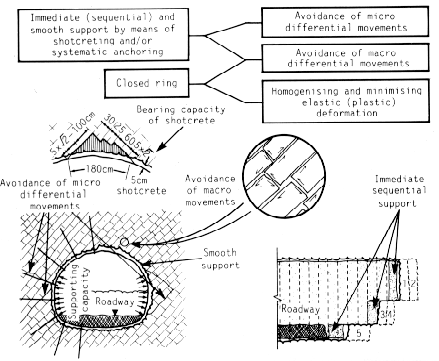
Fig. 2: Simplified definition of the principles and effects of the NATM.
The improved revolver shotcrete machine was developed in Allentown, Pennsylvania in 1911, to protect slopes with sprayed concrete. The first recorded application of shotcrete in tunnelling is in the United States in the early 1920s where it was used to fireproof mine drifts. The original advocate of the use of shotcrete as an immediate support in squeezing ground, instead of the more traditional heavy timber or steel support, was Anton Brunner, a little known mining engineer from Salzburg who in1954, assumed full responsibility for using shotcrete to stabilise squeezing ground in a diversion tunnel for the Runserau power plant.
In 1964, Professors Müller and Rabcewicz applied the shotcrete method to the Schwaikheim Tunnel and began to explain the method on a more theoretical basis in terms of newly developed concepts of rock mechanics.
The first successful application of the method in soft ground in urban areas was in Frankfurt/Main in Germany in 1968 when Professor Müller interested the contractor Beton- und Monierbau to adopt the method and build a test tunnel to demonstrate its applicability.
The NATM may be defined as a method of producing underground space by using all available means to develop the maximum self-supporting capacity of the rock or soil to provide the stability of the underground opening. This is achieved by the application of a smooth and appropriately resistant initial support and a final lining which should accept the necessary deformation but guard against the development of rock load.
|
The initial lining may consist of shotcrete, steel arches, and rockbolts, either singly or in combination. One of the first publications to detail design methods for the shotcrete shell was that by Sattler, which was based on research that subsequently appeared in a thesis on the theory of shotcrete by Gobiet. After a few years of NATM practical in sensitive urban areas, model tests and computer analysis, supported by previous scientific research into the field of soil and rock mechanics, resulted in a number of new findings concerning stress redistribution in the surrounding ground during and after a tunnel drive. |
|
If the support system is inadequate, stress concentrations lead to periodic contractions and deformation of bolt plates, or cracks in the shotcrete. Further investigations prove that ground bearing capacity can be sustained by avoiding convergence movements. Therefore, in single tunnel drives in unstable rock conditions, the ring must be adequately supported within a length equal to one-and-a-half times the tunnel's diameter from the face. Extension of the support ahead of the face by forepoling with grouted crown bars, rebar, or metal plates may be necessary to counteract local ground instability.
If the ground has poor cohesion. the material inside the three-dimensional stress field has to be supported. This can be achieved either by forepoling, by leaving a wedge of unexcavated earth to prop the face or, in extreme cases, both.
In squeezing ground the rate of excavation has to be adjusted to the setting rate of the shotcrete. The invert shotcrete, the final phase of closing the ring, must have the minimum strength to sustain the peak stress which occurs one and-a-half times the tunnel diameter behind the face. Even in more stable rock cut by a full-face tunnel boring machine (TBM), immediate support, if necessary, should be applied within this area.
Convergence, roof settlement and other deformation measurements are common practice and valuable in monitoring the behaviour of the ground, but they give little indication of the actual stress in the shotcrete shell, which is more important to the assessment of a potential failure due to insufficient support. Flat hydraulic pressure cells, first introduced in 1958, are still the only available instrument for measuring such stress.
Measuring stations should not be predetermined but placed where geomechanical changes or alterations in the cross-section dictate. The closer the measuring station to the face, the more frequent should be the readings. More frequent readings are often more valuable than increased instrumental accuracy. Indeed cheaper, more frequent and less accurate readings from carefully chosen locations are more useful than infrequent, but precise and expensive, surveys.
The real value of any instrumentation, however, is only as good as its interpretation, which depends much more on the skill of an experienced engineer than on sophisticated computer software. Moreover, the behaviour of the structure is influenced by unpredictable water ingress, unforeseen geological conditions, geotechnical and tectonic anomalies and, above all, the human factor. Even rock classification systems cannot sufficiently solve these problems. The need for, a flexible concept to meet the everchanging range of influences in tunnelling should, therefore, be obvious.
|
|
If the special provisions for applying the initial support are determined too rigidly by means of calculations and excavations or construction plans, the natural feeling of responsibility of the miners at the face is reduced. This responsibility, the direct reaction of the miners and their supervisor to the given rock conditions, which includes their own safety interest, is an essential component and as important for the NATM as for any other free-face mining method. Planners, consultants and construction supervisors should always be aware of this and try to take advantage of the experience of the tunnel face crews. Use of the NATM concept over recent rears has spread far and wide throughout Europe and into the United States. Japan and South America. It is chosen over other possible tunnelling methods principally because of its application advantages which include free excavation area, considerable flexibility in regard to unforeseen changes in geological and hydrological conditions, flexibility in terms of cross-sectional changes, and rapid mobilisation with readily available, unsophisticated and relatively inexpensive excavation equipment. |
It has been adapted further to suit even softer ground conditions, especially in urban areas. Tight control of the excavation cycle is the key to success in such circumstances. As a result, the multi-phased, side wall drift technique has been developed whereby the face is divided into small areas of excavation. After excavating the side wall drifts, the top heading is advanced, followed by the bench, breaking out the inner walls of the drifts with the bench. Finally the invert is undercut and the ring of immediate support closed. The excavation programme when using this technique, and the distance one face is allowed to advance ahead of the others, depends on the consulting engineer and the quality of the ground.
|
|
There is also the so-called barrel vault method for crossing under railway or road embankments and the door frame slab method, a semi-cut-and-cover method which, in urban areas, keeps disruption of the environment to a minimum. Pre-consolidation of the ground ahead of a NATM face is more critical in softer soils. Ground freezing, compressed air and pregrouting methods have all been used in the past. Forepoling or spiling with rebar is another effective method whereby a canopy of solid ground is created under which the tunnel can be excavated. A newly developed spiling system known as the Grout Spiling Anchor (GSA) both inserts the anchor and grouts the surrounding ground in one integrated step. The anchor is installed inside the hollow tube of the drill rods, the tip of the anchor acting as the drill bit. Once the hole is drilled, the flushing water is replaced with grout and the drill steel is withdrawn leaving the anchor in the bottom of the hole. It is the pressure of the grout injection that keeps the anchor in the hole as the drill steel retracts. This pressure also forces the grout into fissures in the surrounding ground. This system will greatly improve current practices where the initially drilled hole often collapses in brittle ground before the anchor or spiling rod can be inserted. The step-by-step nature of a NATM excavation also allows for the installation of a waterproofing system that will make the tunnel completely watertight. An impermeable PVC membrane is fixed against the primary shotcrete lining before the final in situ concrete lining is cast. |
All these different ways of applying the principles of the NATM concept provide consultants with a wide and flexible range of methods for use in different and changing conditions. There is, however, no real competition between the NATM and other techniques such as shield driving, for example. The most appropriate construction method in terms of safety and price should always he chosen. This flexibility should he provided by the bid documents.
When pricing a NATM contract, the rock is classified and excavation and support are paid for according to the ground classification proposed by the contractor during the excavation and certified by the client. The primary interest of the contractor is a good rate of advance; that of the client is to obtain a safe and economic structure. Agreement on rock classification is, therefore, usually easy to negotiate. The excavation volume is priced by class, and immediate support by its volume per linear metre. The earlier the appropriate support is applied, the smaller is the amount that is required and, hence, the lower is the cost.
In rock, including rock as weak as phyllite, the rate of advance can be as high as 15m to 25m per day with three-shift (24 hour) operations; whereas in soft ground, in such urban areas as Frankfurt, Munich and Vienna, an average of 4m to 5m per day will be difficult to exceed.
|
Price is also significantly influenced by the muck-haulage arrangement, particularly in urban areas. But in recent decades the unit price or price per linear metre has shown constant decline. Technological improvements are partly responsible, as is increasing competition in the construction industry. The NATM tunnels recently constructed for the Deutsche Bundesbahn for the high speed railway lines in West Germany in Bunter Sandstone, a medium-to-soft and in some cases extremely soft ground, produced a highly competitive cubic metre price for the finished tunnel. Depending on the rock class, the cost varies between 250-300DM per cubic metre which represents some 25,000-30,OOODM per linear metre of finished 100m2 tunnel. The cost of excavation and support, including inner lining, of a 35-40m2 subway tunnel in urban areas, in soft ground, in late 1989 was approximately 400-50ODM per cubic metre, or about 15,000-20,OOODM per linear metre. |
|
From 68 tunnel contracts constructed between 1980 and 1986 by NATM for the Deutsche Bundesbahn at a total estimated price of DM3,300 million overrun on the bid price has been only 15 per cent as compared with nine cut-and-cover contracts which, at a final cost of DM500 million, exceeded the contract price by 19 per cent. Although the first NATM tunnel exceeded the tender sum by more than 50 per cent, tunnels that were completed more recently have shown a final price that is much closer to that tendered.
Consistent application of a combination of practice, observation and theory has led to enormous progress in civil engineering. The NATM is now widely used in one form or another and its potential is appreciated and employed by an ever greater number of clients throughout the world.
